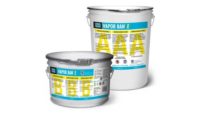LATICRETE products specified in China's Three Gorges project

 LATICRETE was specified for its products and expertise in a magnificent water feature project recently at Three Gorges Mansion in Chendu, China. A state-owned Chinese power company, the China Three Gorges Corporation planned its new southwest regional headquarters to include an exterior architectural feature to reflect the company’s most important project to date: the Three Gorges Dam. The dam, placed into operation in 2008, is the world’s largest hydroelectric power plant.
LATICRETE was specified for its products and expertise in a magnificent water feature project recently at Three Gorges Mansion in Chendu, China. A state-owned Chinese power company, the China Three Gorges Corporation planned its new southwest regional headquarters to include an exterior architectural feature to reflect the company’s most important project to date: the Three Gorges Dam. The dam, placed into operation in 2008, is the world’s largest hydroelectric power plant.
Three Gorges Mansion headquarters was an 800-million Chinese Yuan ($128 million U.S.) investment that lies in the southern portion of the Chengdu high-tech zone. The project consists of two buildings, a 19-story north tower and an 18-story south tower, that are connected at the base of the building. Company leadership envisioned a wall of water between the buildings that would flow much like the water rolls over the Three Gorges Dam. To fulfill their vision, Three Gorges turned to Los Angeles-based architectural firm Water Entertainment Technologies, also known as WET Design, to create a project worthy of the surrounding scenery.
WET Design is best known for its nine-acre Fountains of Bellagio in Las Vegas, and the company has designed more than 200 fountains and architectural water features around the world, pioneering many technologies that have become common in architectural fountains, including laminar flow fountains that arise from the pavement instead of from pools, fountains powered by compressed air instead of pumps, and fountains that employ sophisticated underwater robots. Hallmarks of WET Design fountains are that the water itself is the focus.
This was certainly the case for the Three Gorges Mansion. Innovative modeling created a three-story “water curtain” in the open space between the two towers. The architects specified LATICRETE installation materials and LATICRETE team expertise to help them construct a water feature that would last generations. The waterfall feature was 650 feet long, 32 feet high and its installation was difficult. Cement board was affixed to a steel structure using LATAPOXY 300 Adhesive, a chemical-resistant, epoxy adhesive that will bond to most sound, clean surfaces. A second layer of cement board was attached to the first, and the team used LATICRETE 4237 Latex Additive combined with LATICRETE 211 Powder to bond reinforced fabric onto the cement board. Due to the expanse of the feature wall, the installation team set 3 mm expansion joints every 19 feet using LATICRETE 9235 Waterproofing Membrane to protect the structure from cracks.
The final finish was an exterior wall of Basalt mosaic, a surface that is uneven, difficult to grout, and would be exposed to thousands of gallons of water per hour. The team specified LATICRETE HYDRO BAN, a thin, load-bearing waterproofing and crack isolation membrane and LATAPOXY 300, knowing that usage of this product would ensure that the mosaic would not fall off. According to Judy Xie of LATICRETE, "There was no tile grout specified because the stone mosaic surface is very uneven and therefore, extremely difficult to grout. This very precise tile installation process, took approximately twenty days to complete."
Today, the Three Gorges Mansion is a beautiful area attraction that not only honors the surrounding scenery but also functions as the dispatching center of Jinsha River area of the China's Three Gorges Corporation.
Looking for a reprint of this article?
From high-res PDFs to custom plaques, order your copy today!






